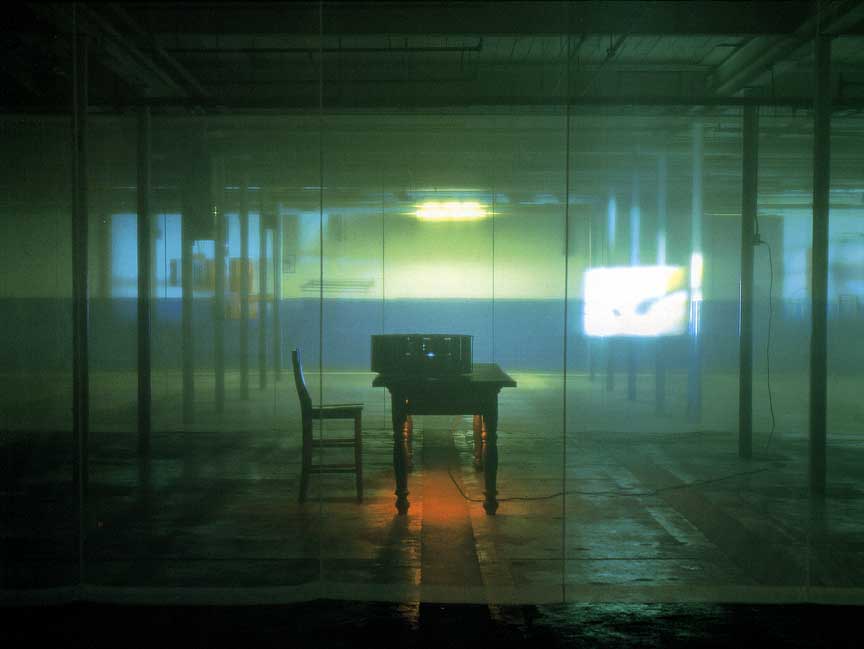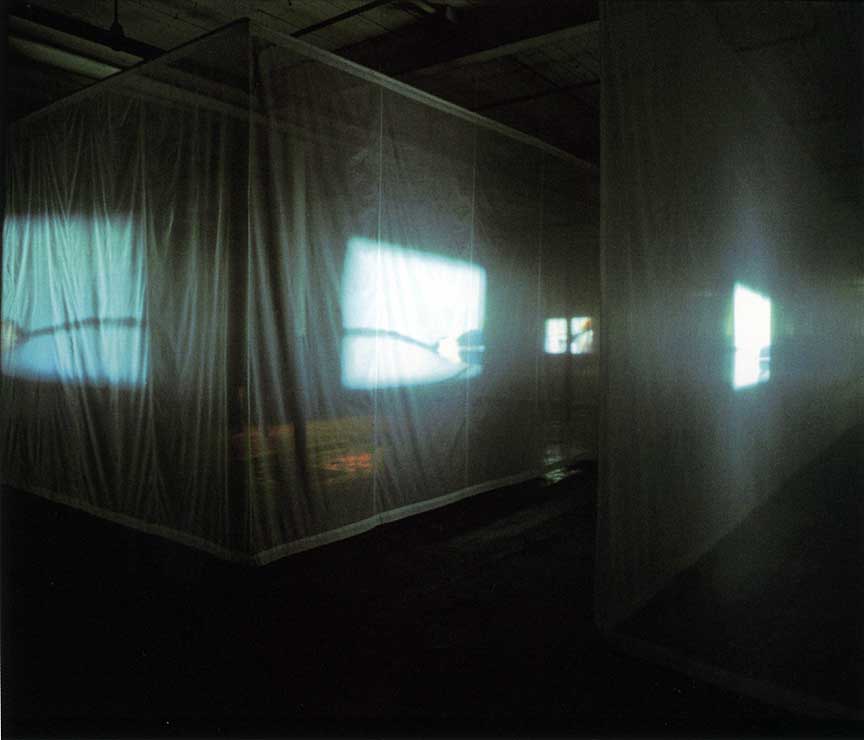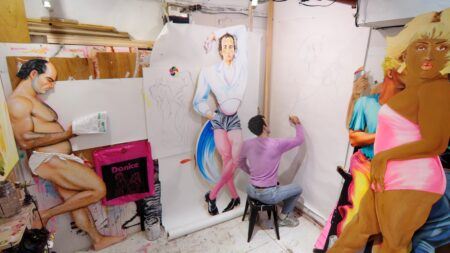Interview
“ghost: a border act”

Ann Hamilton. ghost…a border act, 2000. Installation at the former Ix Factory, Charlottesville, Virginia. Silk organza, tables, video projection, and sound; dimensions variable. Photo by Tom Cogill. Courtesy of the Bayly Art Museum, Charlottesville, Virginia.
Artist Ann Hamilton discusses her personal definition of “installation art,” as well as her 2000 installation ghost…a border act.
ART21: Your work has often been described as “installation art.” Could you talk about what an installation is, and what it means to you, personally, to work in this way?
HAMILTON: I think the form, for me, of working in installation is one that always implicates you actively within it. So that—unlike an object, which we are very comfortable standing outside of and looking at—to work in installation is to work in relation to a particular place and all of the confluences and complexities of whatever it is that creates that [space]. And so, as a viewer, to come in, it’s the experience the minute you cross the threshold: it’s the smells; it’s the sounds; it’s the temperature. It’s how all of those things have everything to do with the felt quality of ultimately what the thing becomes. I started in weaving, in textiles. I think that my first hand is still a textile hand, in some ways. But I was very dissatisfied with the flatness that things actually had when they were done. It seemed like they were dead, in some ways. And working, for me, in the form of installation, in the way that I have—it’s that you’re coming in and you’re in some instances animating the space, and the process is often very social; for me, that part of it is very satisfying. There’s a way that it (the installation) has an ongoing life as it meets the public. Every moment that it’s up, it’s different. It’s different from moment to moment. And somehow it’s that live time—that’s just a factor of the form, really, or something that is characteristic or inherent in the form—is something that makes it continually interesting for me. It’s like there’s no real repetition in that time. Every day you’ll come in, and every day it may be the same, seemingly, but within that there’s a difference, and it’s only—I don’t know, I guess it allows that to be experienced and to be felt and registered.
ART21: And there’s also the way in which installations are impermanent, being specific to a particular place and time.
HAMILTON: Well, certainly. It’s almost like the attitude about this space is not necessarily to alter it or deny it or erase it in any way, but to make present something that’s always here—make it more experience-able, perhaps. And part of that is its live time. And so, the duration of that time means that it’s ephemeral in this form, here. I don’t think it means that it can’t be reinstalled or have another iteration, but that will always be different. The experience of it will be different because of all the factors that actually give this the atmosphere that it has; it won’t be there in another situation or context. I suppose it is that live quality that is the thing that keeps it animate for me. You know, it’s that it’s never quite fixed, and so, I don’t really think that it’s ultimately ephemeral. I mean, I feel like the video could be installed in a lot of different ways, and could take on different layers of meaning, depending on whatever context it goes into. But it will only be like this once.
ART21: That idea ties into the way in which, when you began work on this particular installation, you had originally thought of it being housed in two symmetrical rooms in the Bayly Museum.
HAMILTON: Yes, in some ways I took the model of the two rooms that were at the Bayly, and it was partly that I was thinking that I wanted to have one room be the room of the writer and one room be the room of the reader. And I may still pursue this, either here or somewhere else, a relationship between two ventriloquists—that there’s a ventriloquist in one room throwing [her] voice, and [she is] the writer or the reader, and then a ventriloquist in the other. It’s because in my own process, increasingly, I feel like my process is one of reading, which leaves no material trace. And so, what does it mean if, increasingly, as a maker I’m actually engaged as a reader, which is sort of the larger question behind the work? So, when I decided not to use those two rooms and came here, the two rooms stayed with me, and now they become ghostlike, suspensions of silk organza that sit side by side, so they’re identical in form.
ART21: Do your works embody something you want to communicate to others?
HAMILTON: I think they do. I don’t think that they have a narrative. I’m very interested in my own process of research, recognizing all of the layers of meaning that a very simple gesture can have, without feeling like I need to put closure around it being any one of those. In the little thing that I wrote, trying to describe the piece in advance of it actually existing, I talked about a line, that it’s a divide.

Ann Hamilton. ghost…a border act, 2000. Installation at the former Ix Factory, Charlottesville, Virginia. Silk organza, tables, video projection, and sound; dimensions variable. Photo by Tom Cogill. Courtesy of the Bayly Art Museum, Charlottesville, Virginia.
ART21: Could you talk more about your interest in the line as a divide, as something that divides?
HAMILTON: Do you want me to give you a little more background about the line? I think one of the things is that, in my own work, the material aspect of it has always been the handmaking that’s transparently laid itself out onto the membrane or surface of the architecture in some way, and that’s been this evidence of making. And now, in this, it’s actually not leaving a real material trace but an image. So, the act is now image rather than material trace, and there’s as much a laying-out as there is an erasure at the same moment. I’m interested in the paradox of those, within that relationship. So, when I was sitting down to try to describe what I thought this might become, I wrote: “To delineate: to de-line line within the lineate, the inscription of a line. Wound round an enclosure.” And that’s also what you hear in the audiotape because you hear the voice saying: “Winding round with the hand, and the hand’s enclosure. It announces, fixes, establishes, marks, a visible trace. It is a word, a name, a signature, roving the border between a hiss, sounding the silence of a dividing from, a dividing by, erasures, history.” I don’t think I can say more than that.
ART21: What would you like for people to take away from this piece? What sort of experience or meaning?
HAMILTON: I think that I’m always reticent to contain that too much. It’s like the act of naming. It’s like you want to leave the act of naming, of the work and within the work, open as long as possible, to let the experiences fill it out before it gets contained. So, I think the first thing is that you hope that people come in and that they allow themselves not to name it too quickly, but to actually just feel the presence of it and spend time, to sink into the time of it. But I think that ultimately, out of that, all of the implications of what a line is and what it does or doesn’t do are then the things that you take away with you. And I think behind that, if you step sort of further out, it’s about how we take in, or take responsibility, or step into our own agency in terms of how we make our presence in the world. And this extension of one’s hand outward to touch or to mark is the first offer and reciprocal gesture that we make. And it’s the one that is still our primary agency, even if we live within all sorts of technologies that allow the extension out of that into radio and Internet and whatever is now perhaps more invisible to us. It’s ultimately, I think, about how we step into our own agency.
ART21: What is the title of this work here, in Charlottesville?
HAMILTON: It’s called ghost: a border act. One of the things that’s really interesting—Monica, who is helping, found this out, and I didn’t even know . . . I mean, I certainly saw that there was a lot of fabric being woven, and there was a lot of very fine fabric—but apparently one of the main productions was of the silk that’s produced for coffin linings. So, I didn’t know that, and I thought it was very interesting then, once I made the title, you know—how things that you pick up when you’re actually in a space end up being part of it.



